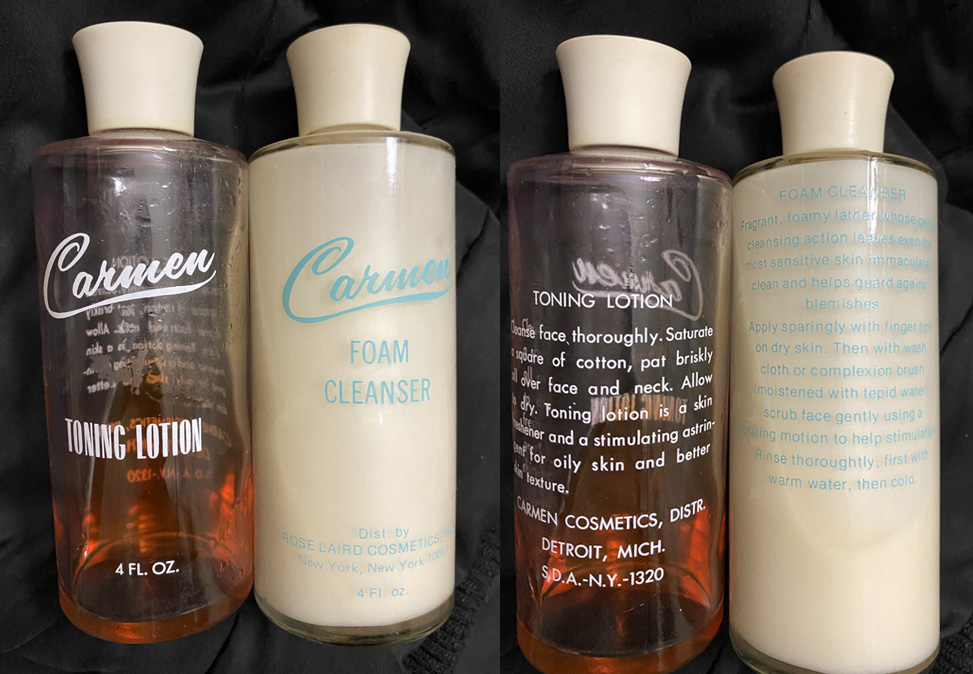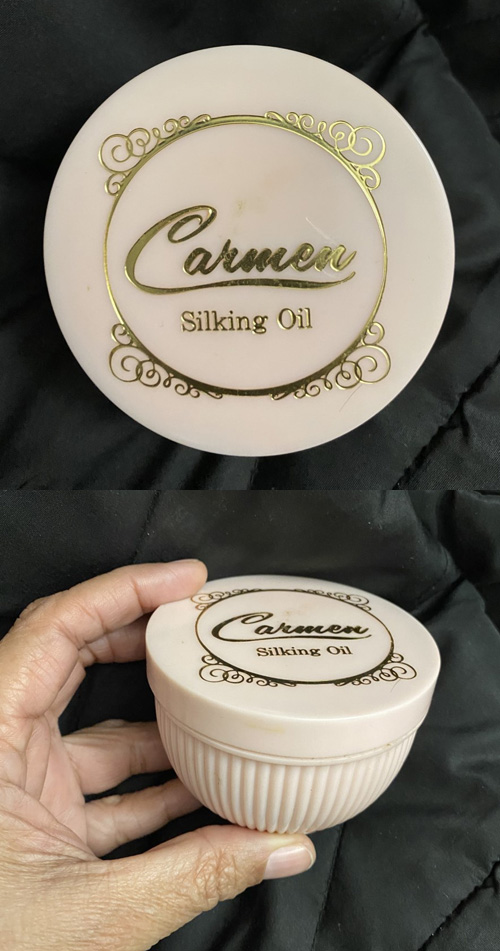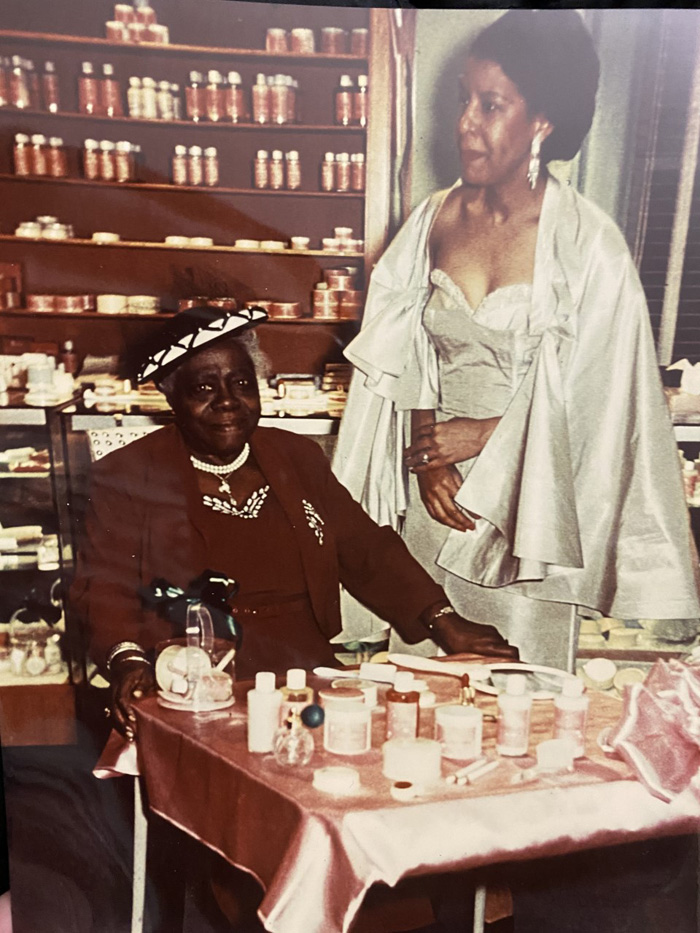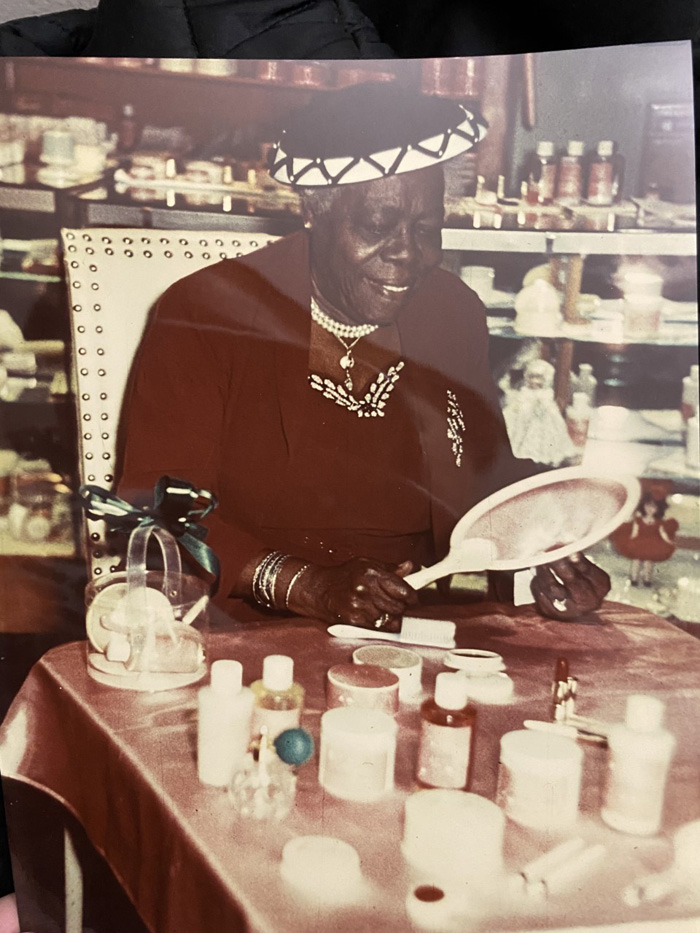While hunting for vintage Christmas makeup a few months ago I stumbled across a brand from the 1960s called Holiday Magic. This won't be a complete history either of the brand or the man who founded it, but it's one of the most compelling (for all the wrong reasons). Buckle up because you're in for a truly wild ride!
In 1964, a California salesman by the name of William Penn Patrick (b. March 31, 1930; d. June 9, 1973) noticed a neighbor having a garage sale of organic fruit-based cosmetics called Zolene. Sensing a new business opportunity, Patrick bought the entire stock for $16,250 (or about $137,000 today). Re-branded as Holiday Magic, Patrick proceeded to start selling them as a multi-level marketing business (MLM). Now, MLMs for cosmetics and other goods had been around for many years prior to Holiday Magic, such as Avon, Mary Kay, Watkins, Fuller Brush, etc. While their ethics are murky – on the one hand it gave people jobs and products that they otherwise wouldn't have access to, on the other they require fairly unsavory tactics – they are not technically against the law. But Holiday Magic wasn't just your average MLM: it was possibly the biggest pyramid scheme prior to Bernie Madoff.
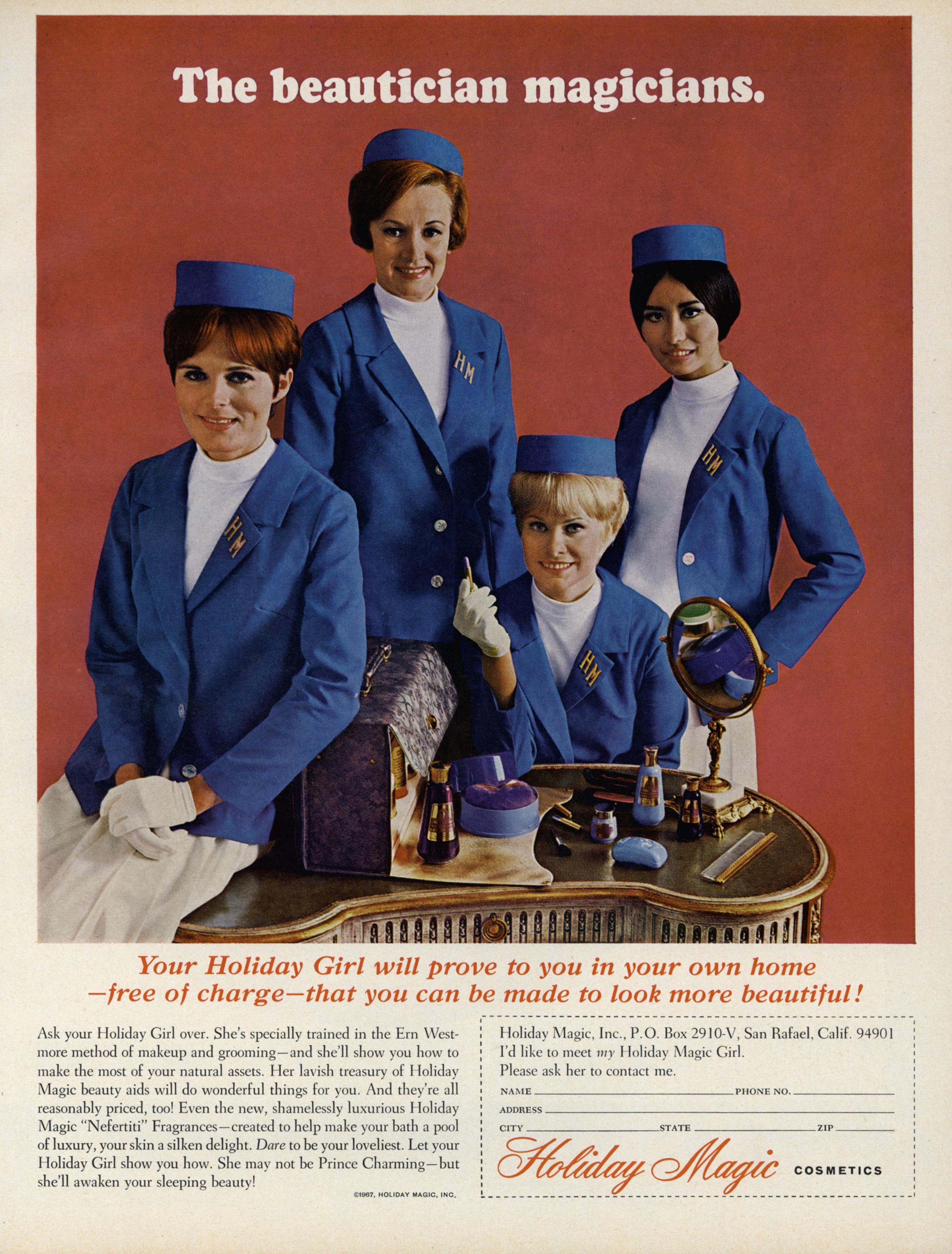
Within a year of its launch, Holiday Magic had made Patrick a millionaire, and by 1967, the company was allegedly earning $6 million per month. The makeup products were quite average – nothing appears to be innovative about them. There was the standard eyeshadow, eyeliner, mascara, brow pencil, lipstick and blush. I would have had my own photos but I have no idea what happened to the objects I purchased from eBay, which sadly has become the norm these days. (It looks like tracking information was prepared but the package never was actually mailed. I've contacted the seller numerous times and have yet to receive a reply, let alone a refund. I guess William Penn Patrick is still working through others to scam customers from beyond the grave.)
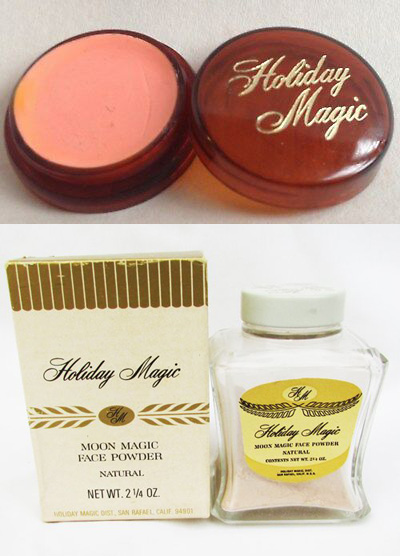
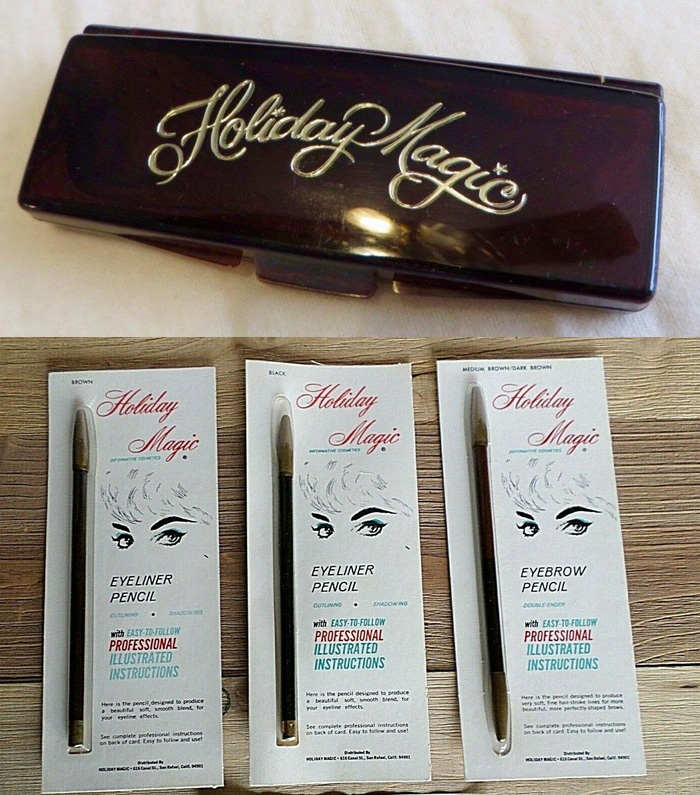
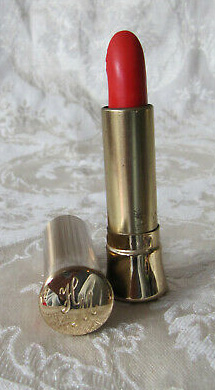
The only thing of interest makeup-wise was the connection to the House of Westmore. The details aren't clear, but it seems Ern Westmore allowed his facial exercises to be used by Holiday Magic, which may have given an air of legitimacy to the brand.
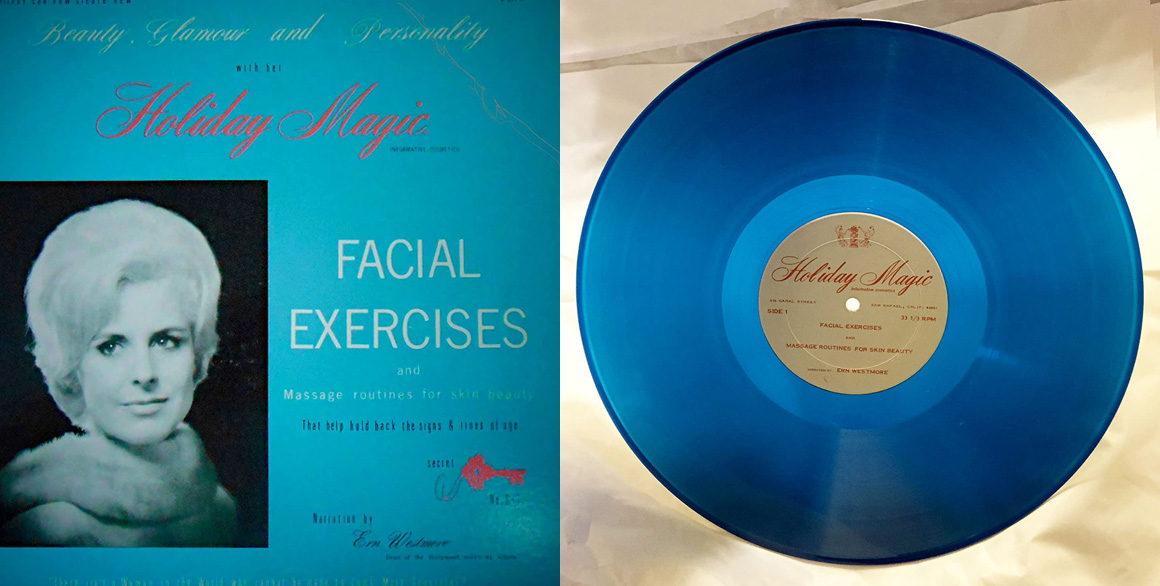
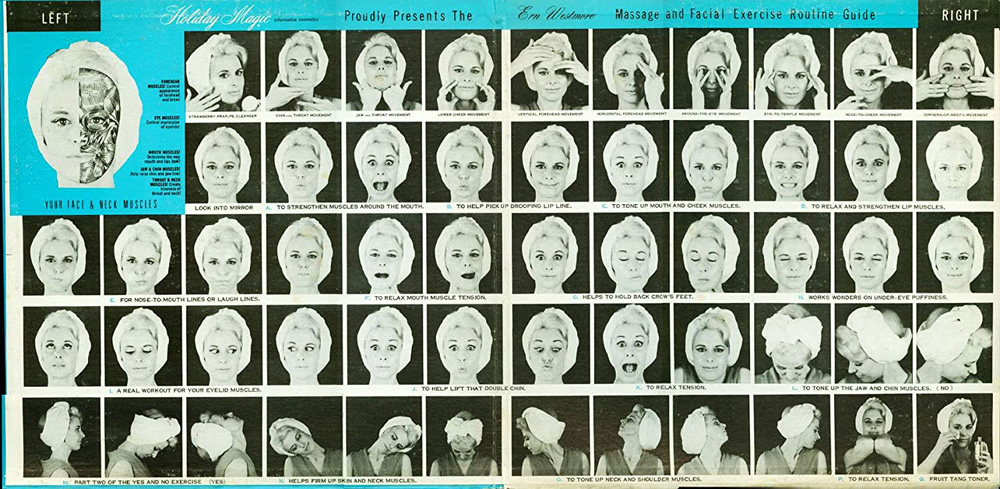
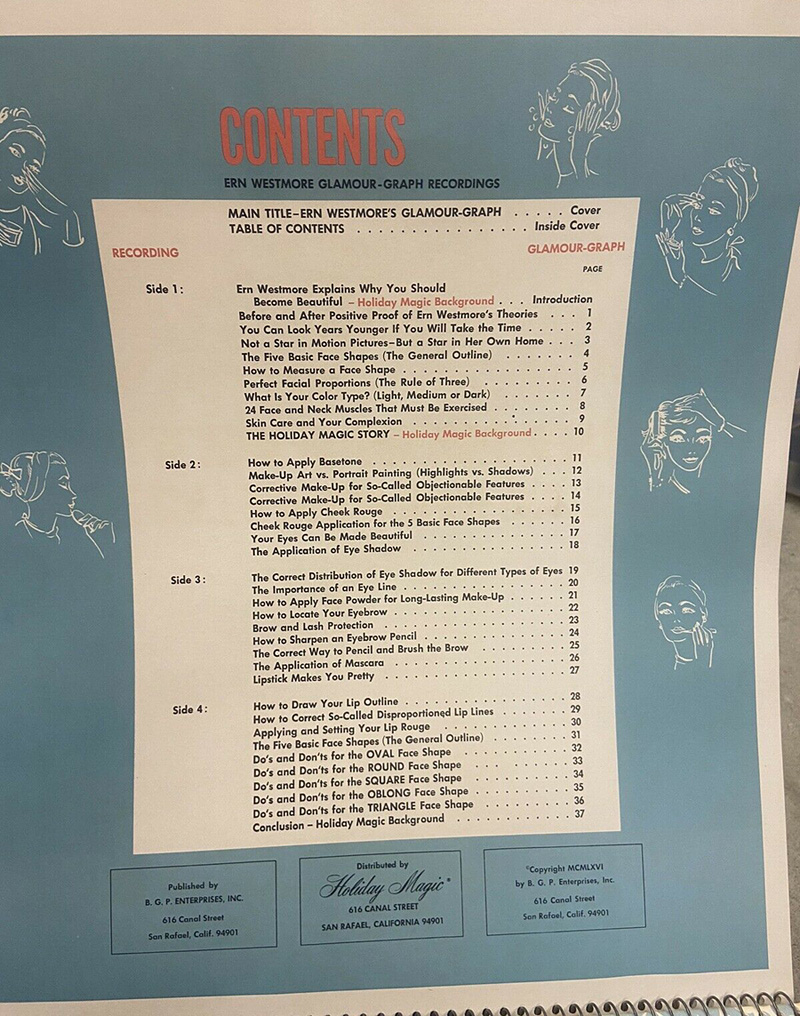 (images from ebay and amazon)
(images from ebay and amazon)
While the makeup itself wasn't all that groundbreaking, the fruit-based skincare was fairly ahead of its time. The two women who founded Zolene, Helene Fly and Zoe Swanagon (hence the company's moniker, a combo of their first names), were committed to using fresh ingredients without preservatives, and did a lot of research on skincare recipes that had been circulating quite literally for centuries. They were even writing a cosmetics history book!
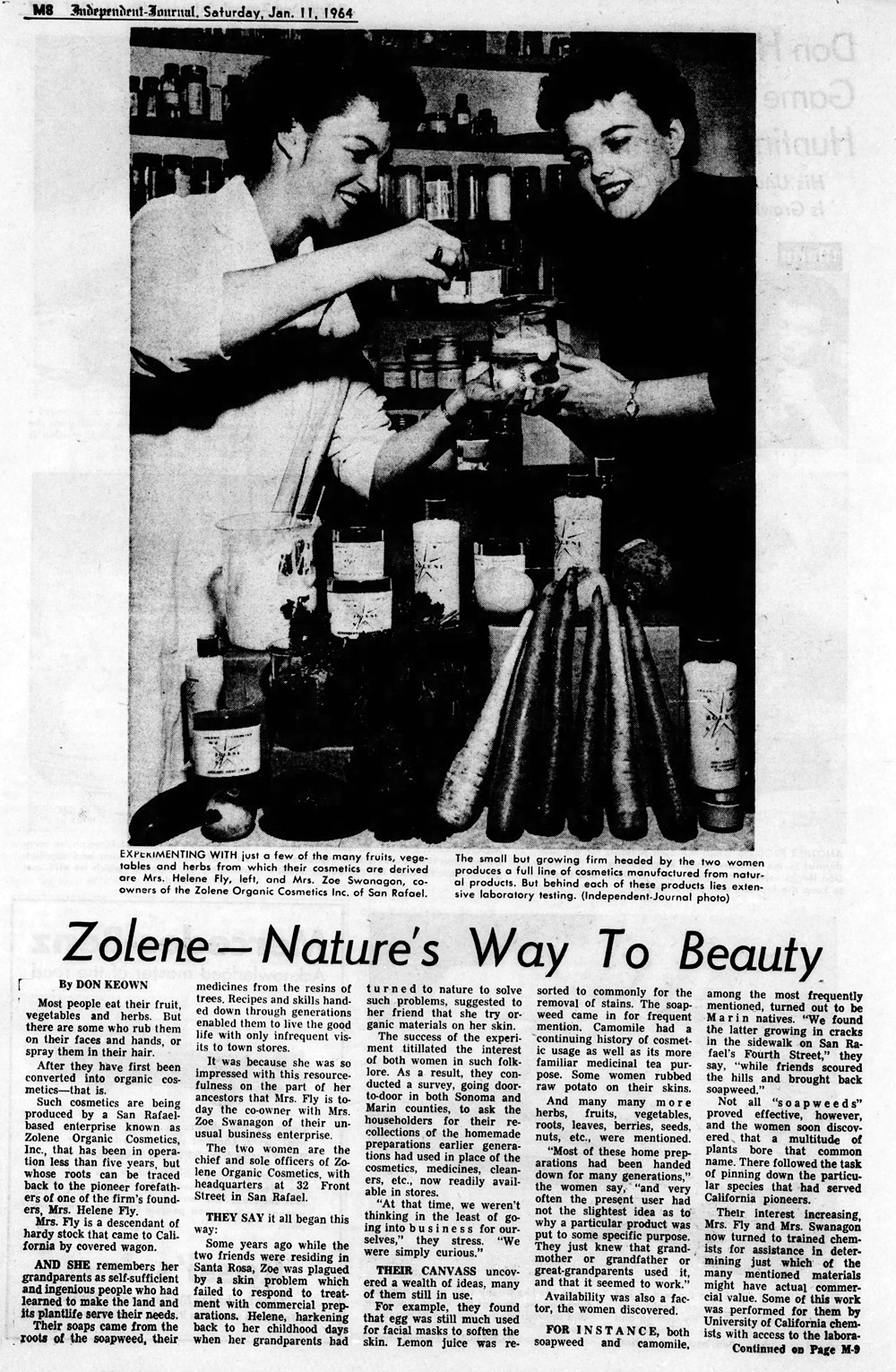
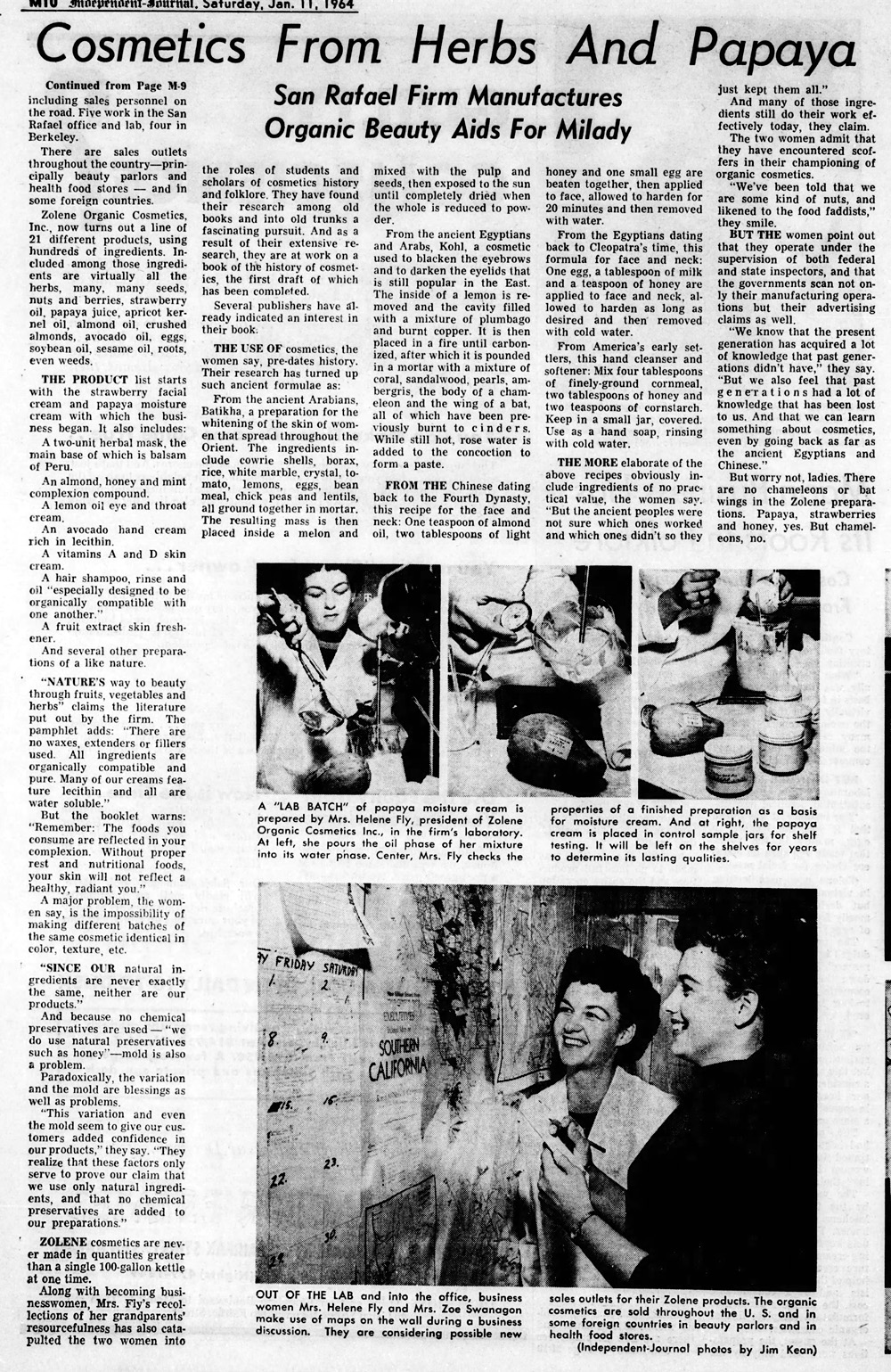
A lot of their products remind me of LUSH or 100% Pure's offerings. And I really wish I could find them, I love the Mid-Century Modern star packaging. Anyway, Zolene continued to supply Holiday Magic with its concoctions until 1967 when the founders became aware of Holiday Magic's business practices. But the company's lack of innovative makeup did not deter it from making a fortune for Patrick. In pyramid schemes, profit is not made by selling products but rather recruiting more salespeople – the products themselves have nothing to do with how the money is made, so it doesn't matter if they're any good. According to The Snapping Point, a website about business scams, the four characteristics that separate pyramid schemes from MLMs are:
- the only way for consultants to make a profit is to recruit other consultants.
- consultants are required to ‘inventory load’, or constantly inventory to profit.
- consultants are operating in a ‘saturated market’, or a market where there are more sellers than buyers.
- consultants are required to sell products for a fixed price (‘price-fixing’).
This book explains it in more detail. Basically, the only way for sales reps to make money was not by selling products but through essentially "buying" more sales people, convincing them to make an "investment" in the company. Unlike regular MLMs, where by the majority of product purchased by sales reps is actually sold to customers, in pyramid schemes most of the product does not reach them. In Holiday Magic's case, in 1967 it was estimated that 55% of their product was not distributed to customers, with sales reps having entire garages full of makeup. In 1973, an FTC attorney stated that he could find no evidence of products being sold directly to customers, only to "master" and "general" distributors, while the former president of Holiday Magic, Benjamin Gay, testified that less than 10% of products sold to distributors ever reached customers. "There could be sawdust in those jars. The cosmetics were there as a front," he said. The way in which Holiday Magic's hierarchy was arranged, Holiday "girls" could invest $18.91, "organizers" $109.71 to $501, "master" distributors $4,500 (plus a $250 training fee that was never mentioned until the investor signed the contract), and "general" distributors $8,750, plus training fees.
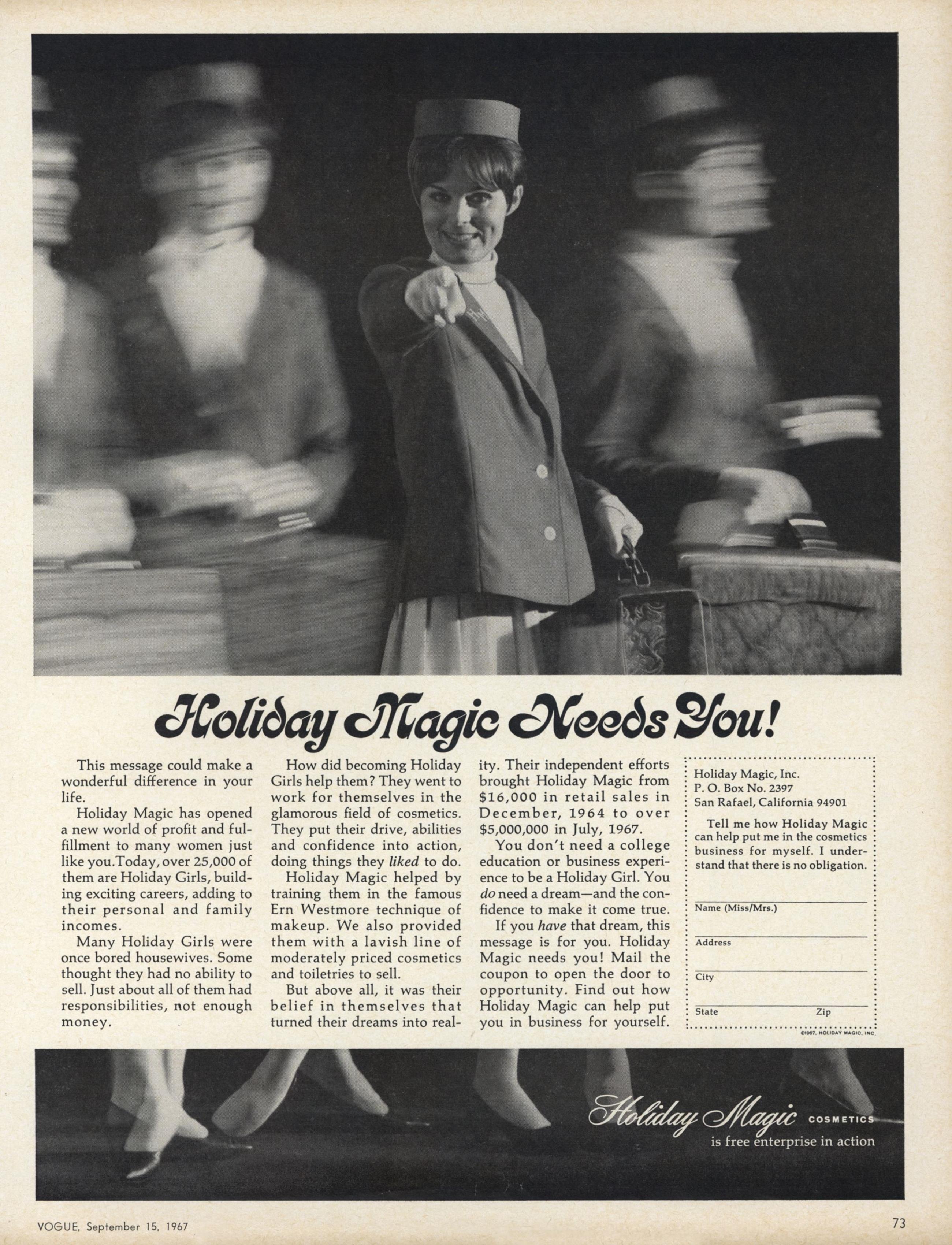
(image from archive.vogue.com)
In addition, Patrick was known for other aggressive, highly immoral practices that went beyond pyramid selling. While Holiday Magic did not officially go bankrupt until 1974, as early as 1967 the company was charged by the California State Attorney General's office for "false and misleading advertising" in which the ads claimed distributors could make roughly $2200 a month (or $18,600 nowadays) working full-time. In retaliation, he took out full page newspaper ads attacking the state attorney general. Basically, any time the company faced a legitimate lawsuit, Patrick would double down and countersue, claiming that his constitutional rights were being violated. But the coup de grace was Leadership Dynamics, a "training institute" for Holiday Magic representatives established by Patrick and then-company president Gay in 1967. Sales agents were not required but "encouraged" to take a training course for a mere $1,000, while those higher up on the pyramid were required to take courses there. However, Leadership Dynamics was not so much training as it was torture; according to a 1972 exposé entitled The Pit, among the many cult-like techniques used to humiliate and brainwash sales reps were severe beatings, being locked naked in cages or tied to a cross, forced to sleep in coffins and, of course, racial slurs hurled at the Black attendees. I'm not sure how much of the book is true, but several newspaper articles as well as an article in Newsweek detail the abuse and numerous lawsuits brought about by attendees who supposedly sustained serious injuries.
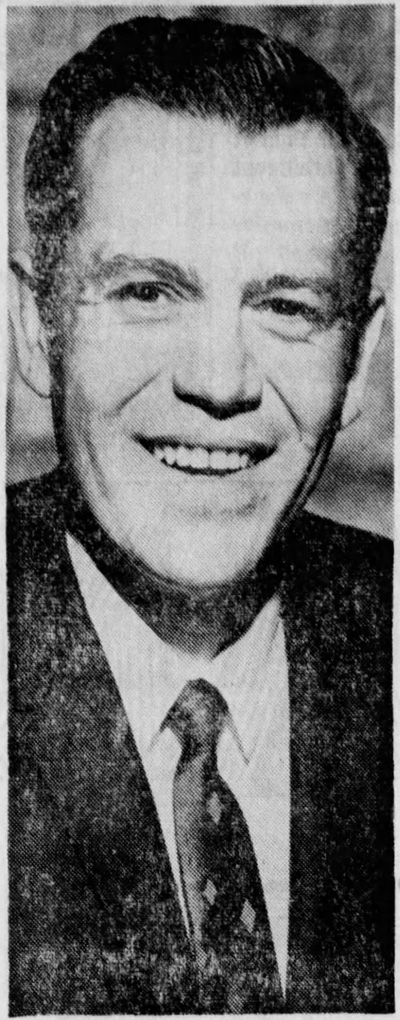
The exceedingly punchable face of William Penn Patrick.
Patrick also dabbled in politics, running against Ronald Reagan in California's 1966 gubernatorial race as an "ultra-conservative Republican" with the slogan "Stop the Commies at Cal". Gee, color me shocked that a money-hungry narcissist was the complete opposite of liberal. His political views are not surprising; many rich white mediocre men truly believe the conservative myth that success is due to hard work (bootstraps!) and brilliance, rather than their own privilege, dumb luck or directly screwing over other people. Indeed, as one former Holiday Magic employee reminisced in 2016, "The whole organization (or lack of) was absolutely bizzare [sic], run by a bunch of frat boys with not a business degree among them. But they had a Phd in pyramid schemes." A couple of other tidbits:
- In 1967, as president of the "Victory in Vietnam Committee" he attempted to run a recall campaign against an Idaho Democratic Senator, because you know when Democrats win an election it's because they stole the race (insert eyeroll here). When the AFL-CIO organized a boycott of Holiday Magic, Patrick promptly sued them.
- His wife, Marie, was going to be a doctor but abandoned her plans shortly after marrying him to work as a teacher, largely to support them both after Patrick's string of failed businesses. Once Holiday Magic achieved success, she began attending meetings with Patrick because "otherwise, I'd never see him".
- On September 24, 1972, one of Patrick's vintage planes, an F86 Sabre piloted by the general manager of Spectrum Air (another company owned by Patrick) crashed into an ice cream parlor shortly after takeoff. The pilot escaped with a few broken bones and scratches, while 22 on the ground died, including 10 children. Patrick wasn't directly responsible, but the fact that he allowed it to be flown speaks volumes about his complete disregard for others.
- On June 9, 1973, Patrick died in a crash while performing stunts on another one of his vintage jets, a WWII plane called a P51 Mustang that, again, any regular citizen should not have had a license to own, let alone fly. He also managed to kill a colleague who was in the plane with him, a 30 year-old director of Holiday Magic in Finland named Christian George Hagert. SMDH.
A few months after his death and a spate of lawsuits in multiple states, as well as a $5 million suit from Avon, Holiday Magic's new president, along with Patrick's widow, announced that the line would be sold "along conventional marketing lines" and get rid of the pyramid aspect of their sales. They also promised a "fair" method of reimbursing roughly 3,000 of the Holiday Magic distributors in California who had been swindled. The SEC's ruling earlier that year claimed that 80,000 individuals had been bilked out of $250 million, so it's not clear what happened to the other 77,000 people who were ripped off. In May 1974 there was a class action settlement of over 31,000 members that established a trust fund of approximately $2.6 million, but that's pennies compared to the actual amount investors lost. Even in 1980 people were still writing to their local paper about the various lawsuits that had been filed and whether they'd get their money back.
But the big issue I wanted to highlight in this sordid tale is the fact that Holiday Magic seemed to have actively sought out Black communities in the U.S. to recruit distributors. While some other MLMs such as Avon, Fuller and Watkins targeted Black sales reps and customers, in their cases it seemed to be more a matter of expanding their market reach and at least supplying steady jobs rather than overtly preying on marginalized people. (Stay tuned for more about Black people's roles in various MLM cosmetic companies.)
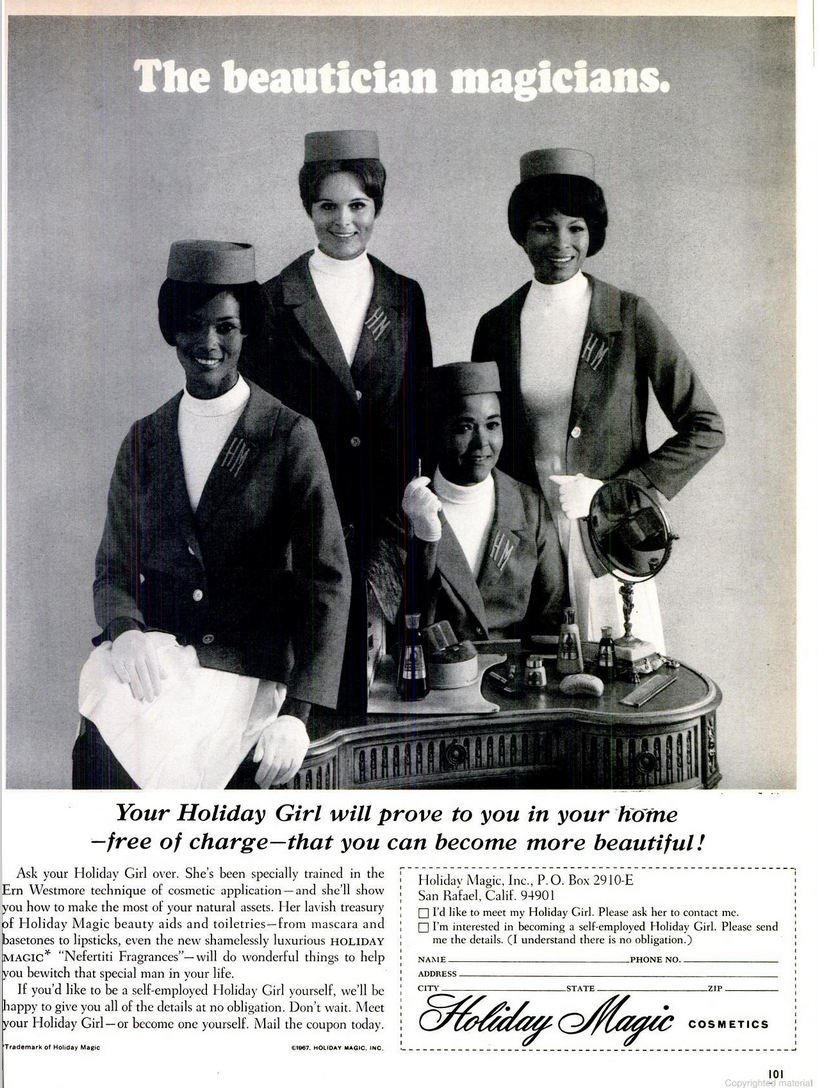 (image from books.google.com)
(image from books.google.com)
I really wish I could find some numbers to further support my theory, but it appears the scheme disproportionately affected Black and other POC investors. "The real tragedy is that Holiday Magic appeals to minority people who want to get rich," remarked SEC staff lawyer Louis F. Burke. Patrick bragged in 1968 that 2 of his top 6 distributors in the U.S. were Black, but even if that were true, it's not necessarily a good thing. As a former distributor noted, Holiday Magic's setup was "like being thrown into a dark pit. The only way you can get out is to drag another person into the pit and step on his shoulders." For the most part, Black customers would only be further disenfranchised if they bought into Holiday Magic. As if that's not bad enough, the company didn't even attempt to formulate any products for deep skin tones. As one wise Black would-be Holiday Magic salesman pointed out in 1975, the line was intended for white people: "Holiday Magic packaged cosmetics for fair-skinned people. Now why in the world would I want to sell light lipstick to Black women?" At least Avon tried to come up with products that would be suitable for Black customers.
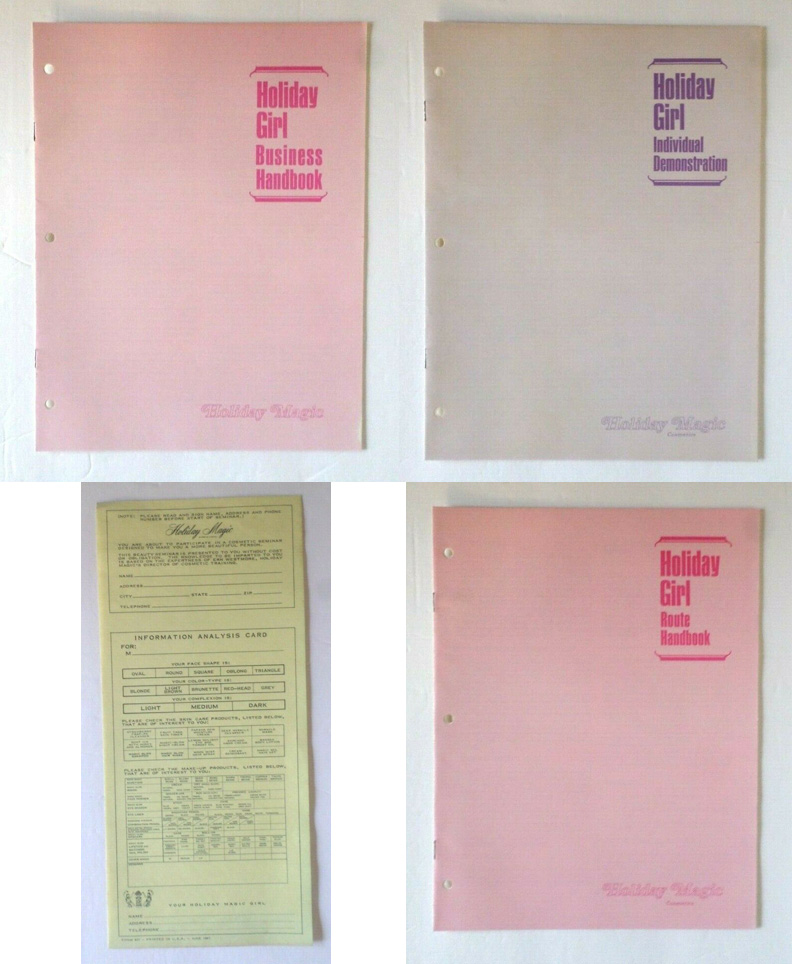
(images from ebay)
In the UK, it's estimated that the West Indian community lost £33 million in the early 1970s, and 26 people committed suicide after losing everything. These figures are somewhat corroborated by a British publication called Grassroots, which in 1974 reported that Holiday Magic targeted "almost exclusively West Indian and Asian communities" in the Midlands region. It's incredibly heartbreaking considering that people were taking out second mortgages on their homes to sink £1,000 into becoming a Holiday Magic distributor, only to end up paying at least double that in the long run and ending up far worse off financially than they were before. Note: I know nothing about this Grassroots publication and have no idea how reliable it is, but I don't think their claims are completely baseless.
It was obvious early on that Patrick was going beyond an MLM and into pyramid scheme territory along with the other illegal sales tactics, yet Holiday Magic was being advertised nationally in well-known publications as late as 1969, and still being sold in pyramid form through 1973. (A new Holiday Magic line with a less deceptive sales model was sold through the mid-'80s.) Perhaps it was a combination of systemic racism and his unbridled wealth that Patrick's sham wasn't stopped before it did so much damage. Maybe if he targeted only wealthy white people he would have been shut down sooner? Then again, Madoff did just that for about the same amount of time.
Anyway, despite what the show's creators say, I think the short-lived TV series On Becoming a God in Central Florida was based mostly on Holiday Magic – even more so than Amway. Everything, from the cult-like behavior and "motivational" mantras spewed by Patrick to the garages full of product and targeting of BIPOC communities has an uncanny resemblance to Holiday Magic.
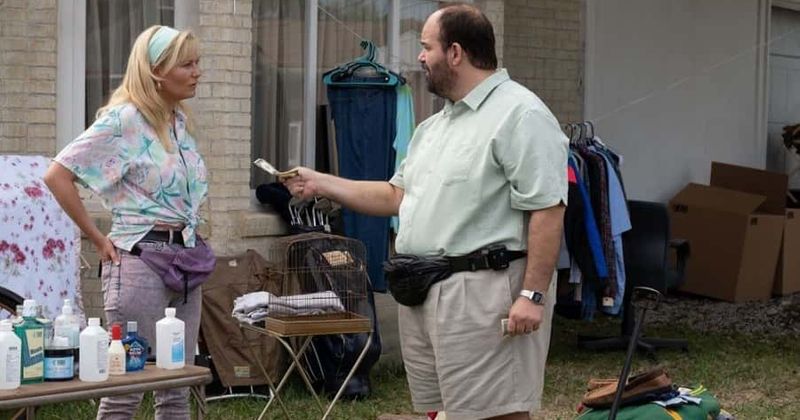
(image from meoww.com)
Thoughts? Had you ever heard of this brand? I promise I have a much more positive story on the way. 😉
Sources: In addition to the links throughout this post, here are some newspaper articles used.
"Holiday Magic Inc. Offers Tasty Cosmetic Products," Asbury Park Press, September 17, 1967.
"The Real William Penn Patrick," Daily Independent Journal (San Rafael, CA), December 28, 1968.
"Cosmetics Firm Files Suit Against Competitors," Harford Courant, May 18, 1972.
"'Torture Training' Basis for Suit by Students," Associated Press, August 16, 1972.
"22 Die as Ex-Fighter Jet Hits Ice Cream Parlor," Chicago Tribune, September 25, 1972.
"Patrick Hit With $5.2 Million Suit," Daily Independent Journal, October 19, 1972.
"Holiday Magic Hit With Two Big Suits," Daily Independent Journal, February 22, 1973.
"4.2 Million Suit Names Patrick," San Francisco Examiner, March 19, 1973.
"The Magic Pyramid," Daniel Grotta, The Philadelphia Inquirer, April 8, 1973.
"William Penn Patrick, Cosmetics Millionaire, Dies in Plane Crash," The Fresno Bee, June 10, 1973.
"Quiet Helpmate at Patrick Empire Helm," Daily Independent Journal, August 1, 1973.
"20.3 Million Suit Against Patrick Firm," Daily Independent Journal, September 29, 1973.
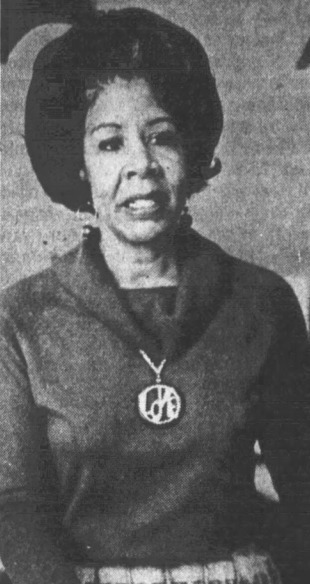 "To borrow Dr. King's phrase all I had, too, was a dream. I got into the business mainly because Black women, myself included, had been searching for cosmetics that would look good on them for years. There just weren't any."
"To borrow Dr. King's phrase all I had, too, was a dream. I got into the business mainly because Black women, myself included, had been searching for cosmetics that would look good on them for years. There just weren't any."
– Carmen Murphy
In an effort to dig into Black makeup history, I came across many pioneering entrepreneurs who filled the much-needed gap for Black cosmetics and hair care that haven't really gotten their due historically. I'm not sure whether this is appropriate for a white person to do – I still feel as though it's not my story to tell – but as with my article on Tommy Lewis I figured bringing awareness to bits of forgotten history even through a white lens was better than not doing it at all. If anyone would like to weigh in on how I can do a better job and not whitesplain/whitewash, I am all ears.
So with that caveat in place, let's take a look at Carmen Cosmetics and the savvy businesswoman behind it, Carmen C. Murphy. Carmen Murphy (née Caver) was born on October 20, 1915 in a small town just outside of Little Rock, AR. The second oldest of nine children in an impoverished family, she began modeling to support herself. At the age of 19 she married a pediatrician, Scipio Murphy, and they moved to Detroit. She studied Home Economics and Business Administration at Wayne University. While much larger than the small Southern town Murphy grew up in, Detroit still lacked high-end beauty services for Black women. They were excluded from white salons and the few Black salons didn't have the expertise. "No one knew high fashion. The beauticians used far too much oil and it took two weeks before [the hair] became nice and soft again," Murphy noted. In 1946 she purchased a dilapidated three-story Victorian mansion located at 111 Mack Avenue (or 188 Mack Avenue) and spent $50,000 of her own money turning it into a 24-room salon. In November of 1947, Olivia Clarke, president of the Rose Meta Beauty Products Company and the successful Rose Meta House of Beauty in Harlem, along with Rose Meta founder Rose Morgan and business manager Odessa Trotter, visited Detroit to finalize plans for opening a salon "fashioned" after the original House of Beauty in New York. On May 30, 1948, the space officially opened as House of Beauty, with Trotter serving as beauty consultant. However, I'm still confused as to the relationship between Morgan and Murphy and the latter's role in conceiving the House of Beauty. According to one article, "The business project is the brain-child of Mrs. Murphy, who has had the cooperation of Rose Morgan of the New York House of Beauty…". Could it be that Murphy had the idea of a full-service salon around the same time as Morgan, discovered the Rose Meta salon and then worked with her to develop a salon in Detroit with the same name, yet the two would be totally independent of each other? Or did Murphy purchase her building in 1946 with the intent of opening a Rose Meta-style salon from the start? In of the articles regarding the grand opening, it's referred to as the Rose Meta House of Beauty, as if Murphy's enterprise was just another location of the original salon in New York, but Murphy was actually the owner.
In any case, the House of Beauty was intended to provide "tip to toe" beauty services for Black women. The salon did $76,000 worth of business in its first year, with a staff of 35 serving an average of 200 clients per day, roughly a quarter of whom were white. House of Beauty's operation was particularly innovative for its use of an "assembly line" service where customers received everything from massages to makeup consultations in a streamlined, orderly yet relaxing fashion. Quipped Murphy's husband, "Leave my wife alone, and the House of Beauty would be as large as the Ford plant at River Rouge."
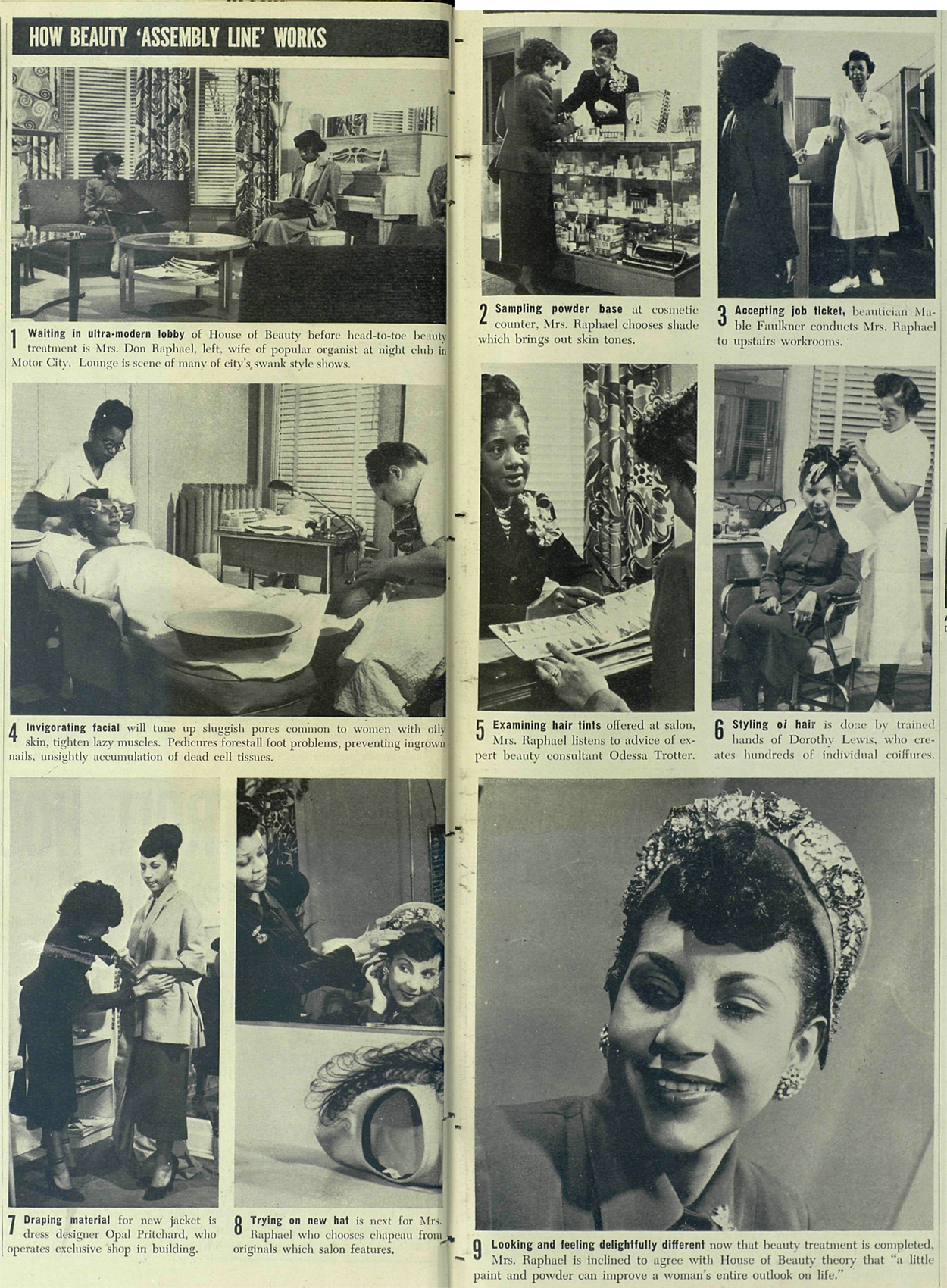
While the salon did well, Murphy was still frustrated by the continuing lack of cosmetics available for deeper skin tones. "Most of us simply would not use any makeup," she said. Murphy approached every major beauty company, including Avon, Helena Rubinstein and Revlon, only to be rejected. "They would tell you firmly that they weren't interested, and that if they sold products for N*groes, it might spoil their image in the white community." But in 1950 the owner of eponymous line Rose Laird offered to help Murphy develop and launch her own line. "She simply said, "I'll help you'", Murphy recalled. Laird assigned her chief chemist, Irving Wexler, to create formulas that wouldn't turn ashy or red on Black skin tones and that would actually match the diversity of Black skin. In 1951 Carmen Cosmetics was officially launched. Around this time the "Rose Meta" portion of the Detroit House of Beauty name was removed, perhaps due to the new makeup line. Rose Meta also sold their own line of makeup for Black women in their New York salons and it's uncertain whether they were sold in the Detroit House of Beauty, but it seems that Carmen Cosmetics would be the in-house makeup brand for the salon starting in 1951. Given the partnership with Rose Laird and the new formulas concocted by Wexler, we can assume they were products that were entirely distinct from the Rose Meta line.
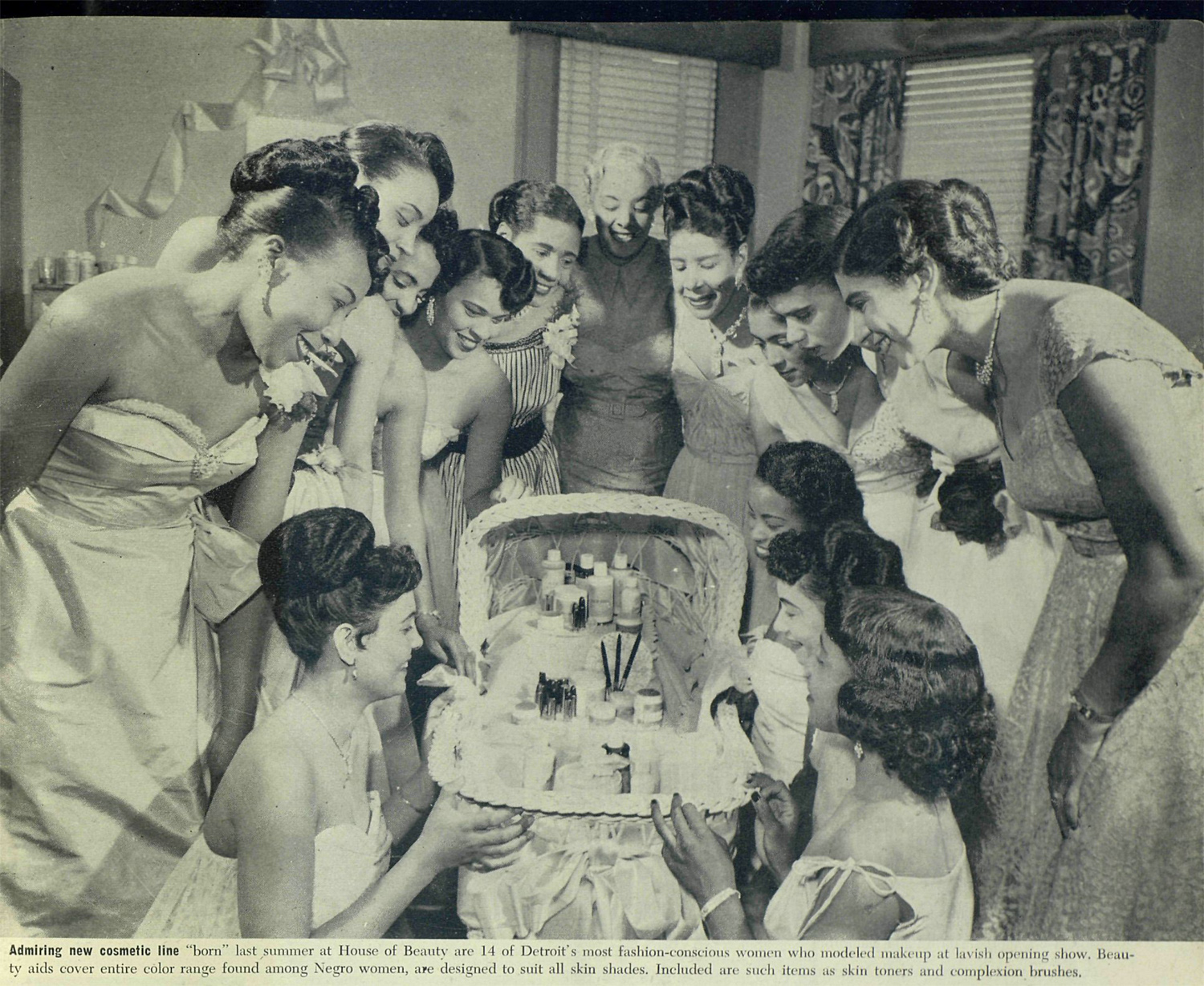
Murphy began promoting her line outside of Detroit shortly after its launch. By 1953 Carmen Cosmetics had a foothold in a handful of other states. Again, notice that by 1953 the salon is referred to as Carmen Murphy's House of Beauty rather than Rose Meta. I'd really love to unravel the mystery of the relationship between the two!
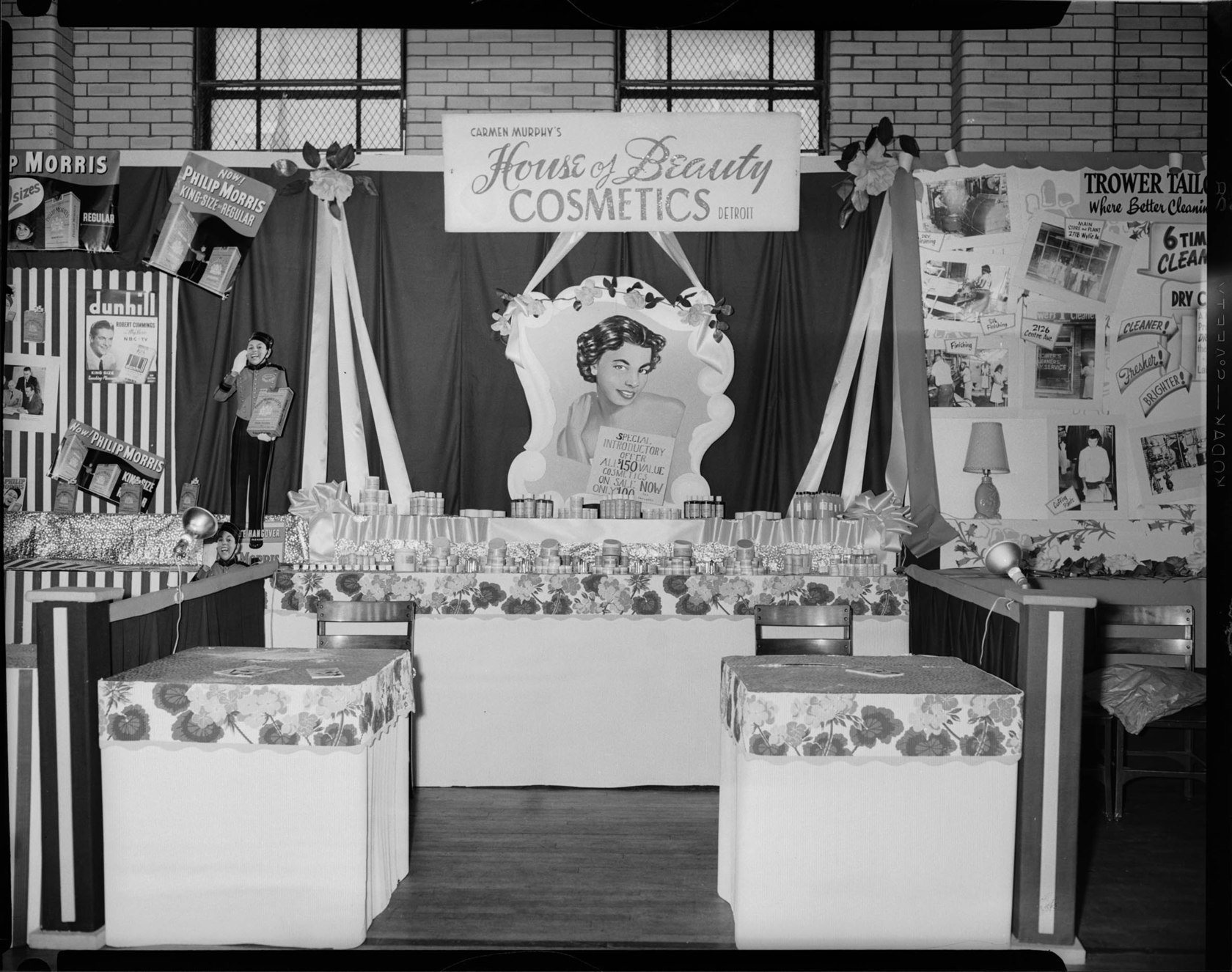
House of Beauty Cosmetics booth in Ammon Center for the Pittsburgh Courier Home Service Fair, June 9-11, 1953. Photo from the Charles "Teenie" Harris archive, Carnegie Museum of Art.
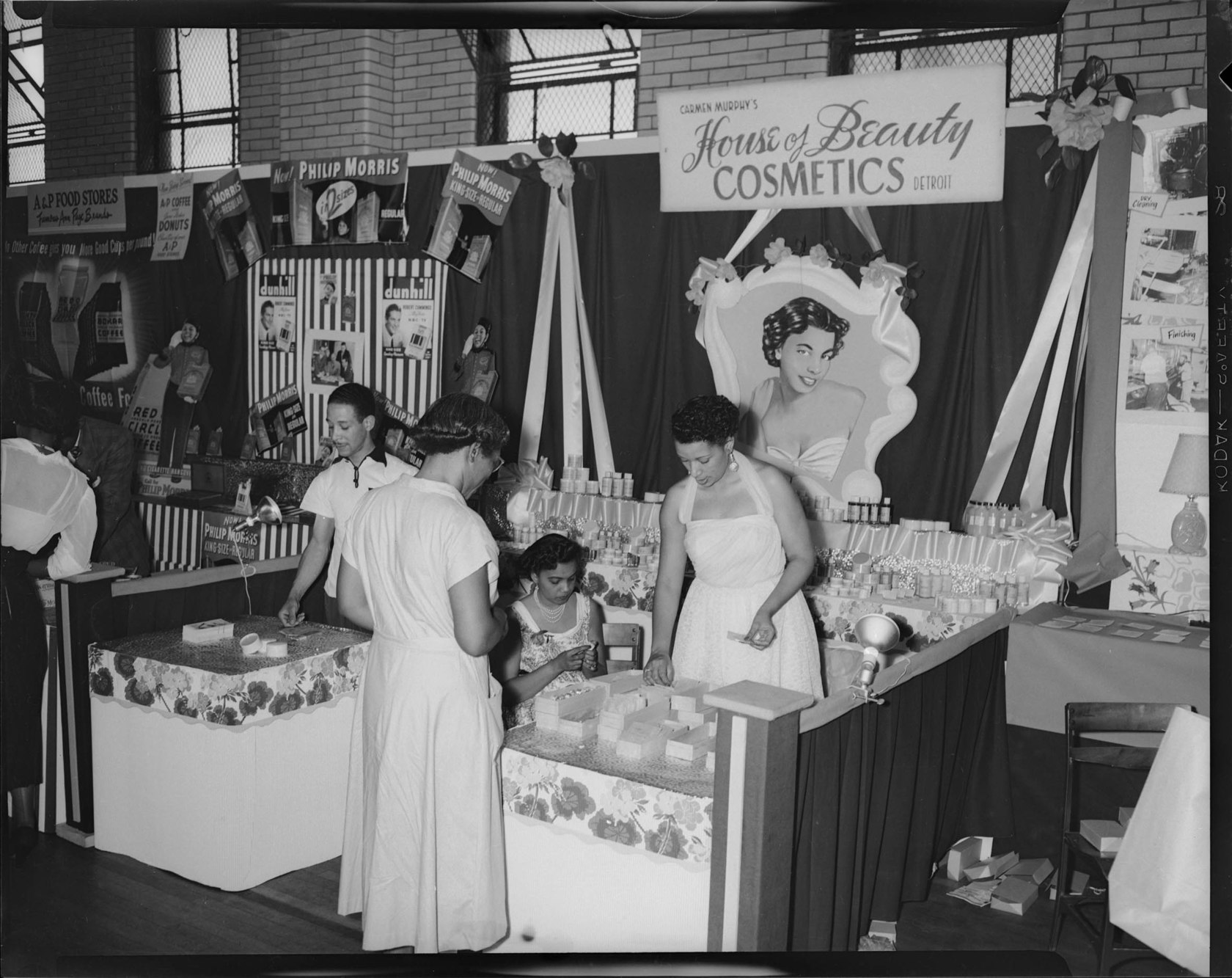
House of Beauty Cosmetics booth in Ammon Center for the Pittsburgh Courier Home Service Fair, June 9-11, 1953. Photo from the Charles "Teenie" Harris archive, Carnegie Museum of Art.
(images from collection.cmoa.org)
In early 1957 a more extensive sales campaign for the line was launched through the Student Marketing Institute based in New York. Roughly 250 salespeople were deployed in 40 major urban markets across 17 states, targeting department and drug stores, Black salons and individual customers. The theme was "everyday beauty for every smart woman", with window displays depicting "the varied roles played by every busy woman daily." The items' retail price began at $1.25, competitive for other major cosmetics brands at the time. Six shades of face makeup were offered along with face powder, mascara, brow pencil, blush and 6 lipstick colors.
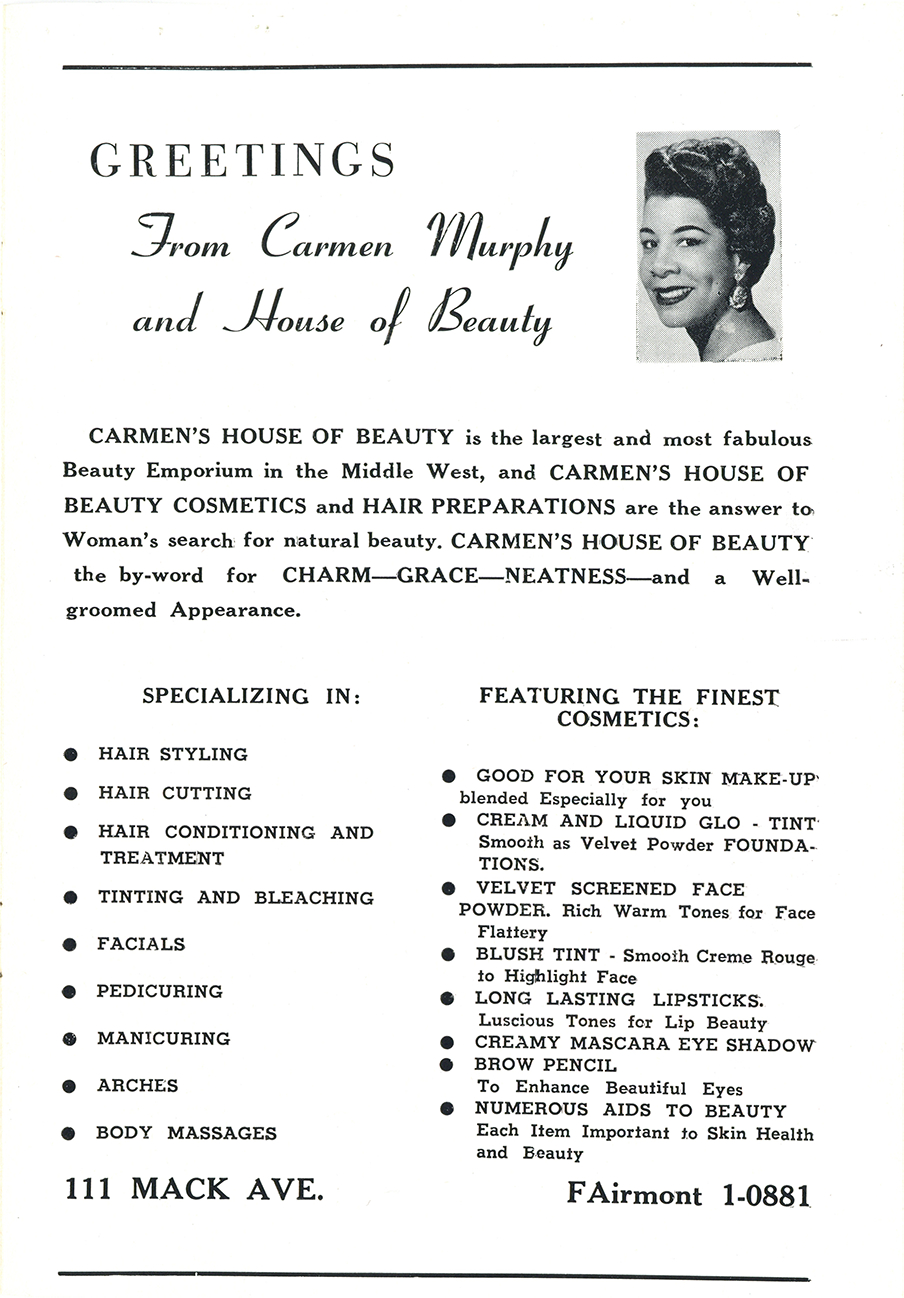
House of Beauty ad from the 1957 Picture book of business and program of annual Trade Week campaign of Housewives League of Detroit. Burton Historical Collection, Detroit Public Library.
(image from detroitpubliclibrary.org)
In 1963 the salon had outgrown its original space and was moved to the Great Lakes Insurance Building at 8401 Woodard Avenue. The Small Business Administration denied Murphy a loan despite the success of the original salon, so she and her husband had to use their own savings and borrow on their insurance to open at the new location. Nevertheless, in April of that year Carmen Cosmetics made its world debut. This article is useful but cringe-worthy for the use of "oriental" to describe an Asian skin tone; however, at least it doesn't refer to Murphy as the "N*gro Helena Rubinstein", which is how she was referred to in several major articles. Ugh. What was part of the success of the Carmen Cosmetics line was that it may have been the first Black-owned line to cater to every skin tone. The formulas for other Black-owned lines were primarily intended for for Black clientele (and justifiably so), but Murphy wanted to accommodate "every female on the face of the earth." Sort of a precursor to the "multicultural" beauty campaigns and products of the '90s, yes?
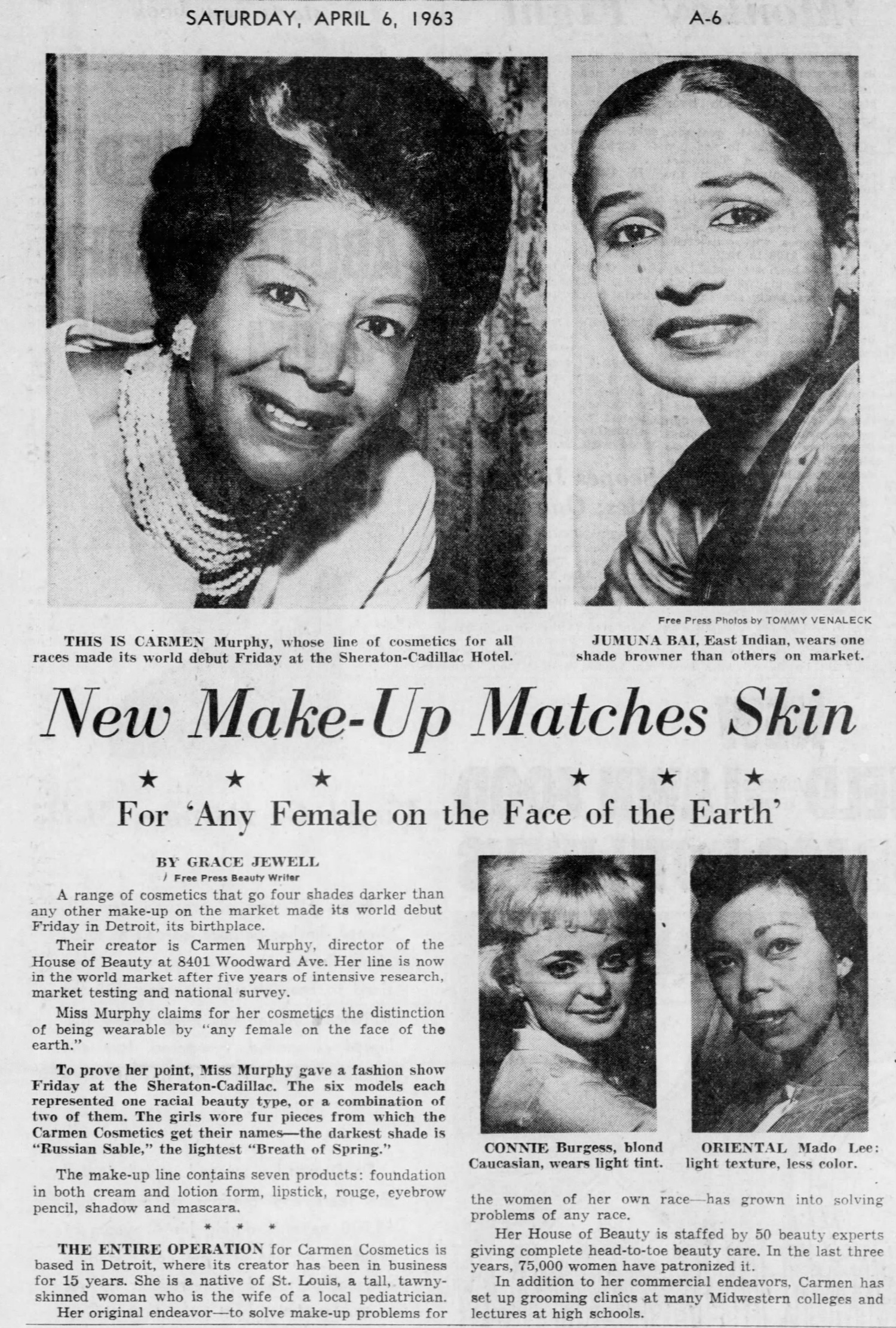
Carmen Cosmetics continued using this as a marketing strategy throughout the '60s, at least when dealing with potential sales outlets.
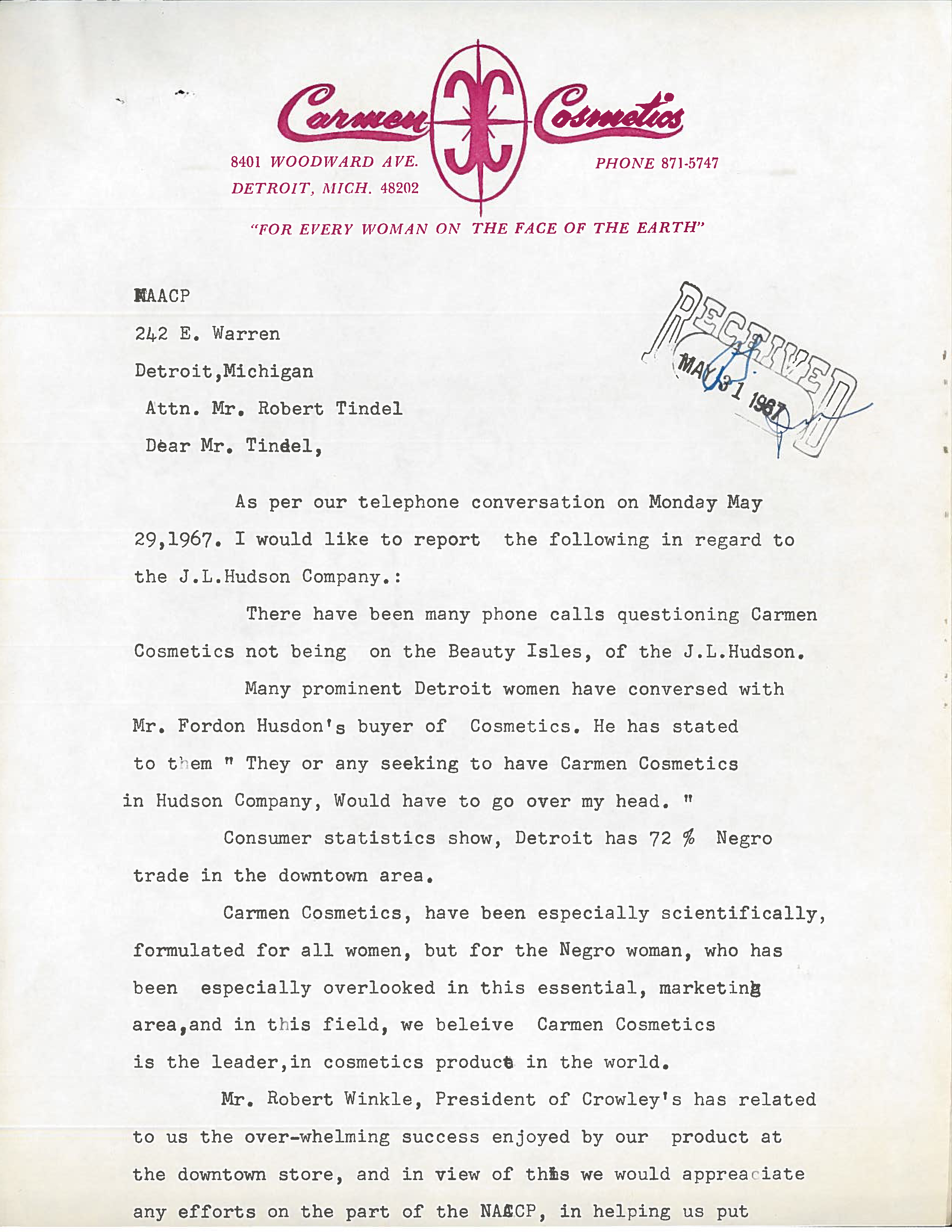
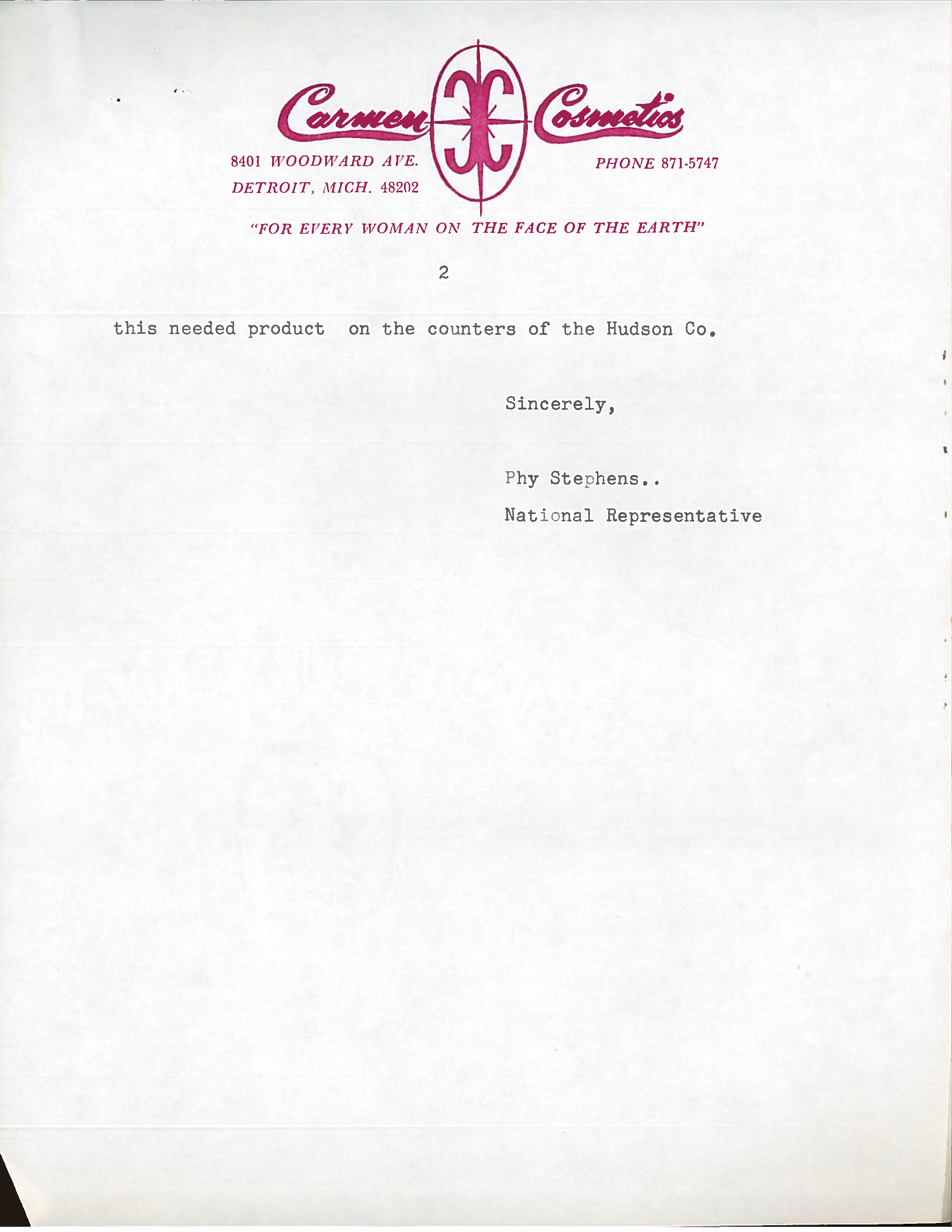 (images from Wayne University library archives)
(images from Wayne University library archives)
In 1966 Rose Laird passed away, and in 1968 Murphy purchased the company for about $175,000 and named Wexler president. Early in the year the salon moved again, this time to 6080 Woodward Avenue to accommodate even more services. This brief profile from the February 1, 1969 issue from Vogue discusses the salon and highlights Murphy's role as the first Black woman to head a major cosmetics firm. While other Black beauty pioneers such as Madame C.J. Walker and Annie Turnbo Malone were well-known for their hair care products and services, and there were some Black-founded lines that offered products for deeper skintones (Rose Morgan's Rose Meta, La Jac, Valmor, and Overton's High Brown powder come to mind) Carmen Murphy was among the first to focus on providing a comprehensive range of cosmetics for Black women, and the first to land significant business partnerships to distribute it. What's also remarkable is that Murphy's business did not rely as much on direct sales as other companies that courted Black customers did at the time (Fuller, J. R. Watkins, etc.) The salespeople for Carmen Cosmetics were responsible for getting the line into stores or doing in-store demonstrations, with less emphasis on going door-t0-door to individual clients. From my understanding, there were no Carmen Cosmetics "dealers" as with Avon and the like.
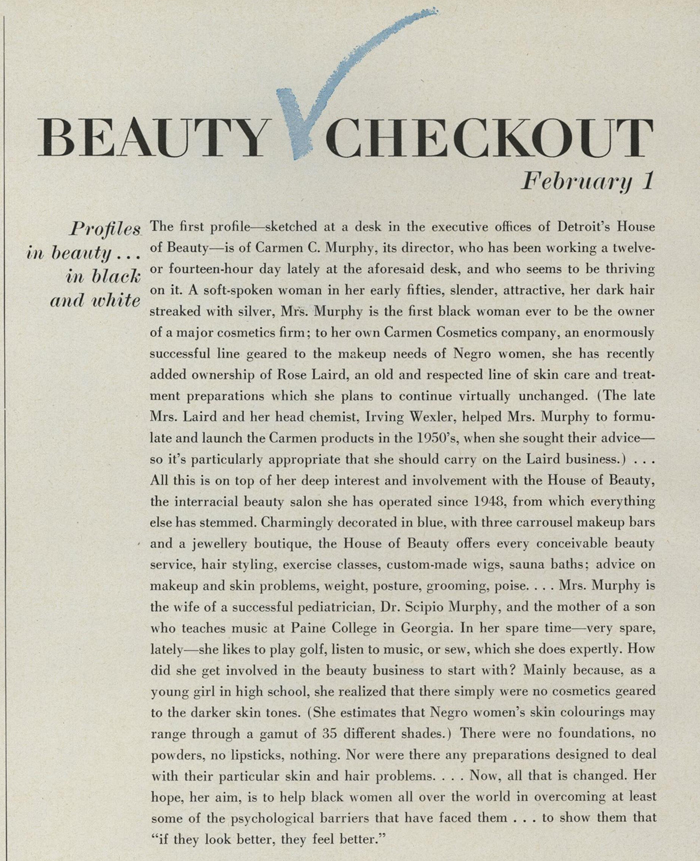 (image from archive.vogue.com)
(image from archive.vogue.com)
From late 1968 it's unclear what happened next to the business. By then Murphy had landed a deal with Universal to supply her line to their film studios and was in negotiations with Bristol Myer (producer of Clairol) for international distribution, but it's not specified whether that arrangement went through, since according to an article from January of 1969 she was still considering it along with 2 others from major corporations. By 1971 Carmen Cosmetics was sold in Woolworth's, Kresge and Lamston stores, but an article in October of that year refers to a "big" deal that did not take place because she needed a loan to seal the final agreement, and the SBA again refused a loan. Murphy laid out how systemic racism prevented Carmen Cosmetics from expanding further. "Basically, the financial institutions do not want to see us succeed in big business. They will loan you enough to get you started, usually just enough to get you in trouble. Being refused by banks has been a blow to me. I feel that, if you become large, and if you become a real threat on the market, they decide to box you in…white people are trying to prove that we do not have the ability. Given the opportunity, we will fail. This is a planned, white, negative approach to help. We will fail, and this will come back at us for years to come…a white business woman definitely would not encounter this problem. She would have a line of credit, something we never had." Referring to the House of Beauty, she concluded: "My dream has not been fulfilled here." Although this occurred nearly 50 years ago, it demonstrates exactly why we need programs like Juvia's Place and Glossier's grant programs today. The system is still incredibly unjust, bigoted and actively preventing Black entrepreneurs from fulfilling their vision.
In 1974 Murphy retired as the House of Beauty's owner, and there's basically no readily available information regarding what happened to the Carmen Cosmetics line or the salon after that. There was a brief mention in a November 1975 issue of Black Enterprise so we know it was still being sold then, but that was about it. I contacted 4 organizations in Detroit and no one was able to locate business records for House of Beauty or correspondence for Carmen Murphy. Nor could anyone find her obituary. She was still alive in 1995, when she received an award for her founding of H.O.B. Records (House of Beauty Records), but had passed by 2010 which is when a video of her receiving the award was uploaded. She had two sons, Scipio Jr. who tragically died quite young from polio in 1950, and Robert, an accomplished pianist and music teacher who is also deceased. Her nephew (her sister's son), Van Cephus, was a jazz musician who sadly died by suicide in 2014. From the comments on the aforementioned video it looks like there are a couple of surviving relatives, but obviously I don't feel comfortable reaching out to them for any information they might have.
So as not to end on a complete down note, I want to highlight Murphy's other achievements. Throughout her career she continued to give back to the Black community. In 1958 she started H.O.B. Records initially to fund gospel recordings. She then set up a practice room in the salon's basement for up and coming musicians to use. H.O.B. Records quickly became the launchpad for dozens of talented musical groups.

(image from fhcmag.blogspot.com)
With the cooperation of the Detroit Board of Education, Murphy also spoke at local schools about proper grooming. "All the poverty programs usually come to us for beauty and good grooming touches before they finish. I want young people to take pride in their appearance. Many haven't had the opportunity to dress properly, to act properly or to wear the right things. I want to teach them to take an interest in themselves and the world around them," she said. On the one hand, I suspect, sadly, that "properly" and "the right things" are code for white standards of beauty and decorum. On the other, it's wonderful that Murphy was providing underprivileged Black youth with some of the tools that would aid them in advancing their social and economic status. Along those lines, in late 1969 she began supplying Carmen Cosmetics to American Airlines for use in their Grace and Glamour program, which helped "young girls build confidence through good grooming habits and proper makeup techniques." The program provided mini flight kits containing Carmen Cosmetics to be used by the girls, which they were permitted to keep. The Grace and Glamour program doesn't exactly sound like a bastion of feminism, but it's important to keep in mind that there were very few opportunities available for disadvantaged Black girls at the time. And it seems that at least some of the girls enjoyed the products and the makeup process.
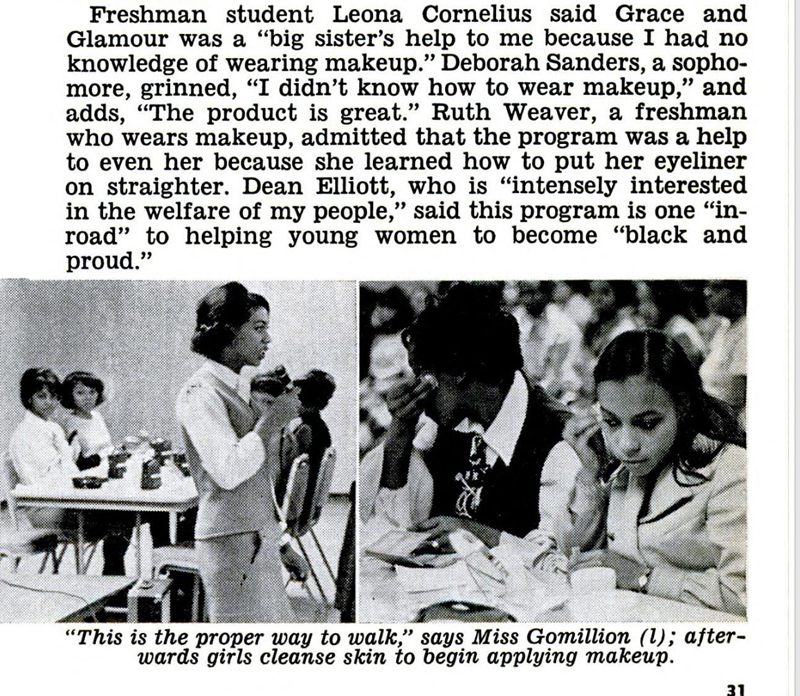 (image from Jet Magazine)
(image from Jet Magazine)
By 1971, Murphy had served as a volunteer driver for the Red Cross, was a lifetime member of the National Association for N*gro Women and NAACP, a member of the African Art Committee at the Detroit Institute of Arts, the women's auxiliary of the Detroit Symphony, the Booker T. Washington Trade Association, the YWCA and the Detroit Roundtable of Catholics, Jews and Protestants, Inc.
As there are still many loose ends to tie up regarding Ms. Murphy – namely, any sort of correspondence, business records, or obituary – I'm contemplating the idea of hiring a private researcher to see if they can find any official business records and additional photos, but it's going to depend on their fees. I saw tons of article "snippets" on Google books and a New York Times article that I was unable to access as well, so there's more information out there. Also, there are plenty of online articles about Rose Morgan but obviously I'd like to do a really in-depth profile of her and also see if I can find anything about her business relationship with Carmen Murphy.
Huge thanks to James from Cosmetics and Skin for his assistance with this article! He supplied the 1951 Ebony article and wrote an excellent profile of Rose Laird if you're interested in additional background to the Carmen Cosmetics line…just go through his whole site, it's chock full of thorough and well-researched information. I also must thank the archivists at the Detroit Historical Society, the Burton Historical Collection at the Detroit Public Library, the Bentley Historical Library at the University of Michigan, and the Charles H. Wright Museum of African American History.
Thoughts? Feedback? I'd really like to do more profiles of early Black beauty lines and makeup artists…let me know who you think needs more attention or if I should keep my white mouth shut.
UPDATE, February 2021: I was thrilled when Carmen Murphy's granddaughter Laura got in touch and shared some memories of her grandmother, along with photos of the Carmen Cosmetics line! Laura visited her grandmother over Christmas and summer breaks during her youth and was able to provide some insight on Ms. Murphy's style, the salon's closure and the products. "She had an image that she HAD to maintain for herself…very feminine, stylish, slim, well-coiffed and manicured. I don't remember a specific beauty regimen, but of course she used her own products and supplemented them with masks, scrubs and lotions made by other companies. She was the first person to introduce me to a loofah and a pumice stone. LOL. Even in her later years, she had to at least have on lipstick whenever we went out (even to the pharmacy or grocery store)…Since I was so young when the House of Beauty closed, I'm unfortunately not sure how and why her business ended. She was quite a visionary, and had some very forward-thinking ideas about make-up and fashion for women of color. But I'm told she made some bad business decisions and trusted the wrong people (who took advantage of her). She was able to survive for several years off of the reputation she'd built in Detroit and the patronage of her loyal customers. After [the salon closed] the things I remember most were the ladies who would come to the house to buy her products when I would visit for the summers. She would have me go to the basement to fill the product orders and if the customers paid in cash, she'd sometimes give me a dollar or two. I didn't recognize the value of what she had achieved until much, much later when she no longer had those things."
Here are some photos from Laura of the actual products! "The Silking Oil was primarily applied to the scalp, but could also be applied directly to the hair to promote moisture retention. The Toning Lotion and Foam Cleanser are pretty self explanatory. The bulk of the packaging that I remember looked like the Silking Oil – pale pink with the 'Carmen' logo on it. (The product packaging changed a couple times, so the items I have were from the last change.) She had cream and liquid foundation and pressed powder in pink compacts, and she named the shades after types of furs – I only remember Sable and Russian Sable, which were the most popular."
She also provided photos of what she believes is Carmen's first House of Beauty. "You can't see the products close up, but they give you an idea of the different types of packaging on the shelves (and yes that is THE Mary McLeod Bethune)."
How amazing! Laura, thank you so much for this incredible update and all the photos.
Sources: As with my previous post, I linked throughout to relevant sources and pulled the rest of the story together from various newspaper and magazine articles, so those additional sources are listed below.
Gale Research International, "Who's Who Among Black Americans," 2002, p. 222.
"Cosmetics Firm Uses New, Unique Sales Approach," the New York Age, January 12, 1957.
Valerie Jo Bradley, "Grace and Glamour comes to Langston University Co-Eds," Jet, January 8, 1970, p. 28-31.
"Why Herb Martin Keeps Chugging Along, Just Like…er…uh…Horatio Allen," Detroit Free Press, October 24, 1971.
Mary Ellen Kirby, "Beauty: Skin deep, then some to Carmen Murphy," Detroit News, October 21, 1968. Article provided by the Charles H. Wright Museum archives.
John L. Dotson, Jr., "Black is beautiful: Carmen Murphy's beauty salons bring cosmetics to N*gro women," Newsweek article featured in the Kenosha News, January 8, 1969.

 (image from books.google.com)
(image from books.google.com)






















